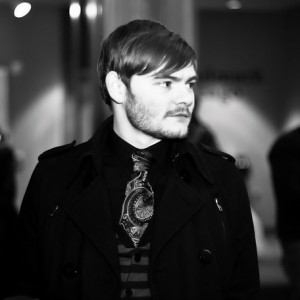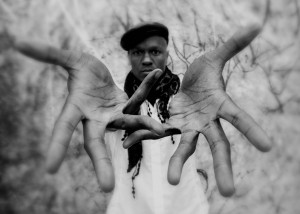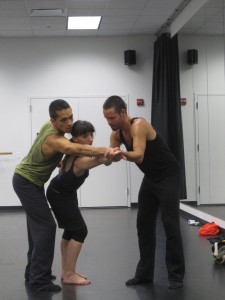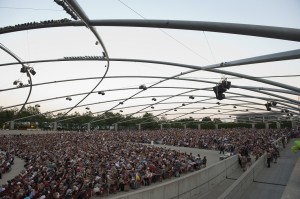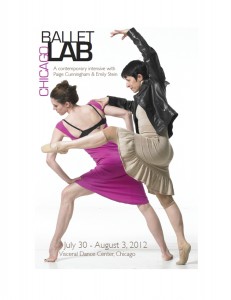
Photo by William Frederking.
Are you a ballerina with an edge? A dancer with classical training, but likes to move more outside of the box? Dare I say, a rogue ballerina? Local dancer/teacher/choreographers Emily Stein and Paige Cunningham Caldarella have a workshop designed just for you. Ballet Lab Chicago is a one-week intensive contemporary ballet workshop being held July 30 – Aug 3 at Visceral Dance Center (2820 N. Elston Ave.). Two morning technique classes – 10:00 to 11:30 and 11:30 to 1:00 pm/teachers will alternate – give you a warm-up and a solid base for an afternoon rehearsal – 1:00 to 3:00 pm – where both choreographers will “workshop” new choreography. On the final day, there will be a works- in-progress showing of the resulting dances. Aside from the full workshop ($300), there are two class options: a 5-class option (you can choose any five classes – $100), or the entire week of nine classes ($150).
Stein and Cunningham met about five years while teaching at the Dance Center of Columbia College. Because they both taught the same level and had some of the same students, they started talking about what was going on in the classes and found they had similar approaches. Columbia’s summer program ends in mid-July and although there are many other companies housing workshops around Chicago, they thought this would be a good time for their students to get some extra classes before school session start up again in the fall.
I sat down with Stein and Cunningham at the Dance Center to find out more about their Ballet Lab.
Why did you create Ballet Lab?
ES: We both are interested in choreographing using the ballet vocabulary, which we don’t always have the chance to do here. It’s also an opportunity for us to get some playtime choreographically that was something more specifically focused on contemporary ballet. There’s a showing on the last day. I think we’re both hoping that it gives us a chance to springboard into some new work next year, either in terms of choreographic ideas that we develop in that week, or in terms of meeting new dancers or finding people we want to work with in the future. We’re both interested in approaching the ballet vocabulary in a choreographic way. I’ve always been teaching ballet, I was classically trained, it’s my first language and my first love, but obviously most of my performing career was in modern dance…very avante garde modern dance. I’m trying to bring the ends of these things together, because in my brain there are similarities.
Can you explain what you mean by “approaching ballet choreographically”?
ES: A lot of my work in the last ten years since I did the solo-commissioning project (working with Deborah Hay), kind of sent me on this journey of improvisation and scores. I’m really interested in structure. Ballet is full of structure, but it’s not improvisational structure. It’s the opposite…or is it? I guess that’s my question. I’m interested in exploring the vocabulary and playing with ideas of structure and score. For example, if I create a combination and then I give instructions of what to do with the combination, what will happen to it? Each dancer will bring something new to it. How open can that be? Or how specific does it need to be in order to be a replicatible piece that’s interesting to watch? Scores are really interesting, but it’s a big risk because sometimes it’s just boring to watch. It just doesn’t work. Can you make it work and make it different every time, or not? A lot of times in improvisation workshops there was “not that”, “not an arabesque”…well, why not? That’s in my body, that’s part of my language. If that comes out, why is that wrong? I don’t mean it to be judgmental. I’m just questioning these things. What if you take these really abstract ideas of score, but you approach them intentionally with ballet vocabulary in your body, as your language…allowing yourself to access that.
PC: I like that. I feel like that is something that comes up. I’ve caught myself working with young students saying, “that’s familiar, don’t do that” and then they shut down. That’s what they know. How do you let them do that, but find a new, interesting approach to it.
How are your teaching styles different?
ES: My class has a classical base, but I approach it from a really somatic point of view. We spend time in class working on mechanical and somatic principles that they can then use in technique. They develop efficiency. They get to know their body better and it’s not just about being able to do stuff, but about finding pathways to do things effectively.
PC: My class tends to be more contemporary ballet, like a ballet hybrid. We’ll do a more traditional barre, but the center work might be phrase work or explore things choreographically, so it isn’t necessarily the traditional ballet class structure. I feel like I was a dance misfit. I started ballet when I was 3, so I had a lot of classical training, then I went to Julliard and had a lot of formal, technical training. I was never going to be in a classical ballet company. Body-wise and the way I approached ballet class, I knew I wasn’t going to be in a ballet company. Then I ended up at Cunningham which was perfect, because I could use a lot of my ballet training, but still be a modern dancer. I never felt like I could fit into a downtown modern dance scene. I wasn’t weighted in that way, so I was in this weird in-between place, but I love ballet vocabulary. For me, it’s exploring taking your pelvis off-center or you may go into the floor and come up to find that verticality of ballet. It’s kind of a mish-mosh approach. There are probably teachers that would call it “bastardized ballet”. I think part of it was when I came here I saw so many students struggling with ballet, because we have generous admissions, we have students that are 18 and have never studied ballet before. I started thinking, how can we approach this so they can see how modern can feed into it, or jazz or African.
ES: You said ballet misfit. That was kind of our point of connection. We’ve both felt that way. We have a ballet background, but we don’t fit into that mold as performers. I feel that for both of us, making connections for the students…trying to make the students understand they don’t live on the ballet planet. There’s one planet, it’s rewarding, it’s not scary or limiting to be able to be able to do all these other things, to be able to think about movement in all these different ways. There’s a place where if you approach it a certain way, ballet really is organic.
PC: Ballet Misfit Academy! That’s what the t-shirt should say.
What’s your end goal aside from a successful workshop?
ES: We’ve been talking for a long time about doing a collaborative show, but we have some extenuating circumstances that are changing the game a little bit. (Caldarella is pregnant.) Both of us look at it as an opportunity. Any time I get to play and make stuff, it becomes something. There is no end goal. Everything is a step to the next thing. We’d like to do the workshop every summer.
PC: Maybe finding ways of connecting with other Chicago organizations. Maybe time it so we have a group of five weeks and make it a larger collaborative intensive.
Ballet Lab Chicago, July 30 through August 3 at Visceral Dance Center, 2820 N. Elston Ave. Spots are still available, register here!
 Since it is hot as *^%! outside today, why not cool off by dreaming of a wintery treat. Today only – until 7:00 pm – Joffrey Ballet is holding a Christmas in July event. Dance classes, merchandise and 50% off select tickets to The Nutcracker are available.
Since it is hot as *^%! outside today, why not cool off by dreaming of a wintery treat. Today only – until 7:00 pm – Joffrey Ballet is holding a Christmas in July event. Dance classes, merchandise and 50% off select tickets to The Nutcracker are available.

